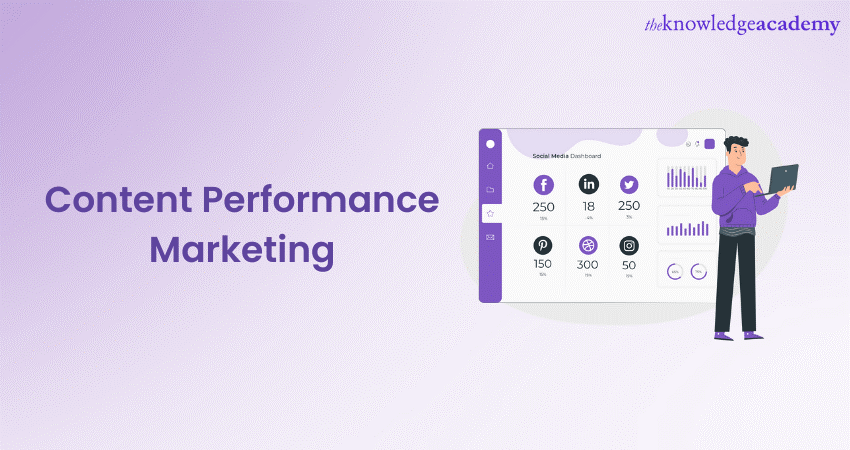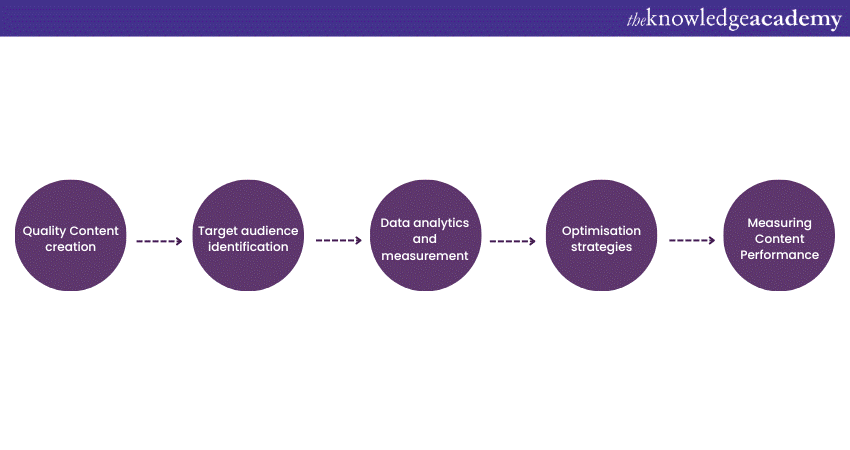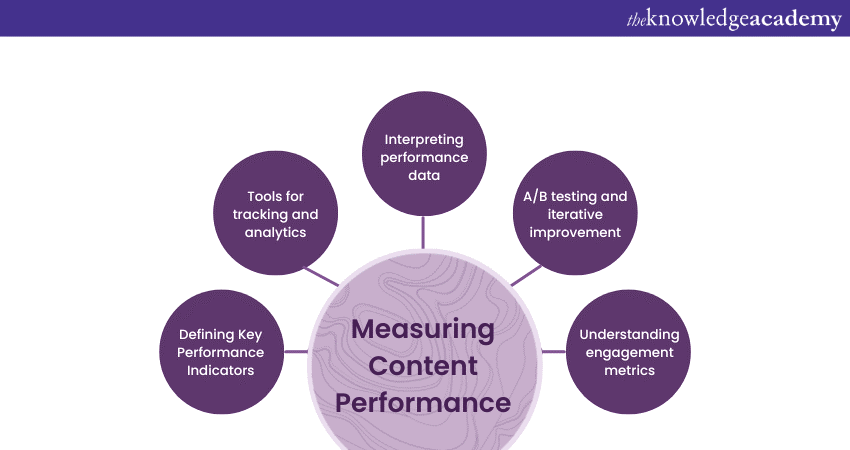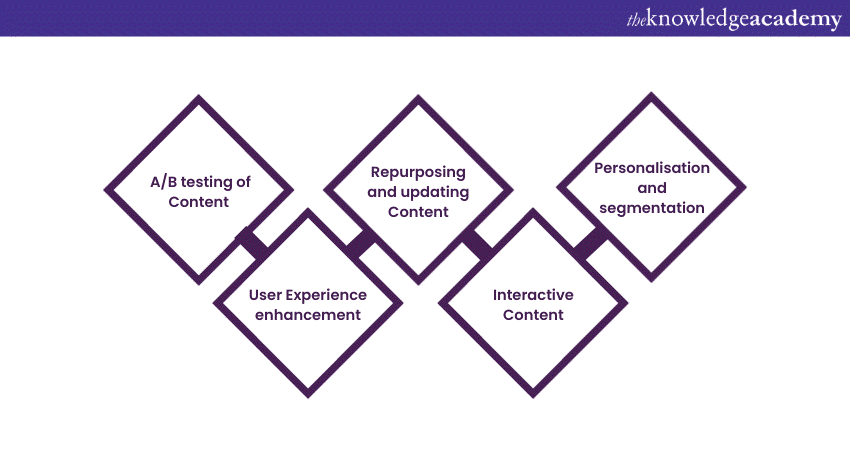We may not have the course you’re looking for. If you enquire or give us a call on +91-181-5047001 and speak to our training experts, we may still be able to help with your training requirements.
Training Outcomes Within Your Budget!
We ensure quality, budget-alignment, and timely delivery by our expert instructors.

Content Performance Marketing is the linchpin of modern brand communication in an age of digital sovereignty. The essence of this discipline is the ability to create Content and make it resonate, engage, and drive meaningful results. It is more than just crafting words, visuals, and videos. It is about creating compelling narratives that captivate audiences and convert them into loyal patrons.
In this blog, we’ll embark on a journey through the landscape of Content Performance Marketing, dissecting its intricacies, challenges, and exploring its trends. By the end, we’ll ultimately understand its role in the ever-evolving Digital Marketing domain.
Table of Contents
1) Understanding Content Performance Marketing
2) Key elements of Content Performance Marketing
3) Implementing a Content Performance Marketing strategy
4) Measuring Content Performance
5) Content optimisation techniques
6) Challenges in Content Performance Marketing
7) Future trends in Content Performance Marketing
8) Conclusion
Understanding Content Performance Marketing
Content Performance Marketing is a strategic approach that centres around creating, distributing, and optimising valuable and relevant Content to achieve specific Marketing objectives. Unlike Traditional Marketing, which often relies on interruptive advertising, Content Performance Marketing focuses on providing genuine value to the audience through metrics.
This strategy involves crafting various types of Content, such as blog posts, articles, videos, infographics, podcasts, and more. Rather than overtly promoting products or services, the goal is to address the audience's pain points, answer their questions, and offer solutions that genuinely help them.
In contemporary times, consumers are inundated with advertisements from all directions. As a result, they have developed an innate ability to filter out promotional messages that do not provide any real value. This shift in consumer behaviour has necessitated a change in Marketing tactics. Content Performance Marketing has emerged as a solution to this challenge.
Ready to take your Marketing skills to the next level? Explore our comprehensive range of Digital Marketing Courses and stay ahead of the curve
Key elements of Content Performance Marketing
Creating high-quality Content is at the heart of Content Performance Marketing. This Content serves as the foundation upon which the entire strategy is built.

a) Quality Content is not only about being informative but is also about engaging the audience and providing them with actionable insights. Whether blog posts, videos, podcasts, or infographics, the Content should captivate, educate, and resonate with the target audience.
b) Understanding your audience is vital to the growth of any Marketing strategy, with Content Performance Marketing being no exception. Identifying your target audience's demographics, preferences, behaviours, challenges, and interests allows you to curate your Content to their needs. This results in increasing the chances of engagement and conversion.
c) Content Performance Marketing is a data-driven approach. Analysing data provides insights into what is working and what needs improvement. This involves tracking key metrics such as page views, bounce rates, time on page, click-through rates, and conversion rates. You can decide on optimisation strategies and Content direction by knowing how users interact with your Content.
d) An effective Content Performance Marketing strategy is dynamic. It means that its evolution is based on performance data and emerging trends. Optimisation strategies involve making data-driven adjustments to Content to improve its performance. This might include refining headlines, optimising keywords, enhancing visuals, and experimenting with different Content formats. Flexibility is key in adapting to changes in user behaviour and search algorithms.
Implementing a Content Performance Marketing strategy
Implementing a Content Performance Marketing strategy requires a thoughtful and systematic approach that aligns with the business's objectives and the target audience's preferences. The process includes a series of interconnected steps that collectively pave the way for success.
a) Setting measurable goals is essential to increase brand awareness, drive website traffic, or boost sales. Selecting the proper Content channels that resonate with the intended audience is crucial once the goals are defined.
b) Different platforms cater to different demographics and Content formats, so tailoring Content delivery to these channels ensures maximum engagement. Creating value and Content is the cornerstone of this strategy. Each piece of Content should be meticulously crafted to provide insights that align with the audience's needs.
c) Incorporating SEO best practices during Content creation enhances its visibility and increases organic traffic. This involves careful keyword research, optimising meta tags, and making Content that aligns with user intent.
d0 Continuous monitoring and analysis become paramount during this process. Regularly measuring Content performance through Key Performance Indicators (KPIs) such as engagement metrics, conversion rates, and traffic sources provides valuable insights into what is working and what needs adjustment. Tools like Google Analytics can offer comprehensive data that guides decision-making.
Ready to master the art of driving results in the digital world? Discover our specialised Performance Marketing Training and uncover the secrets of data-driven success.
Measuring Content Performance
Content Performance Marketing strategy is not just a post-campaign formality; it is an ongoing process that provides useful insights into the impact of your efforts. Effective measurement guides decisions, optimises Content, and maximises the Return on Investment (ROI). To achieve this, a combination of defined metrics, specialised tools, and interpretive analysis is required.

Key Performance Indicators (KPIs) are the compass points that direct your assessment of Content Performance. They are specific metrics that align with your goals. For example, if brand awareness is a priority, KPIs include social media engagement and the reach of your Content. If lead generation is the goal, tracking conversion rates and email sign-ups could be vital. Defining KPIs ensures you measure what matters most to your strategy.
Plethora of tools are available to track and analyse Content Performance. Google Analytics is a powerful tool that comprehensively views your website's traffic, audience behaviour, and conversion rates. Social media platforms offer their insights, offering data on engagement, impressions, and audience demographics. Marketing Automation platforms enable tracking leads, conversion rates, and customer journeys.
Collecting data is the first step; interpreting it is where the real insights lie. Analyse trends over time to identify patterns and anomalies. If a specific type of Content consistently performs well, consider why it resonates with the audience and replicate its success. On the flip side, if certain Content underperforms, dig into the data to uncover the reasons behind its lack of engagement.
A/B testing involves creating variations of Content elements such as headlines, visuals or calls to action to see which version performs better. Testing these elements on a smaller scale allows you to implement changes that positively impact the Content strategy. This iterative improvement process ensures Content is constantly refined to engage the audience better and achieve desired outcomes.
Engagement metrics offer insights into how users interact with your Content. Metrics such as likes, shares, comments, and time spent on the page indicate your Content's level of interest and resonance.
Content optimisation techniques
A/B testing is an important technique that involves creating two or more variations of a Content element and comparing their performance. By conducting controlled experiments with different versions, you can identify which variations elicit better engagement or conversion rates. This iterative process enables you to refine your Content based on data-backed insights.

Optimising the User Experience contributes significantly to Content performance. Ensure that your Content is readable and visually attractive across devices. Mobile responsiveness is crucial in increasing users' access to Content on smartphones and tablets. Implementing simple navigation, intuitive design, and fast-loading pages enhances User Experience and encourages extended engagement.
Successful Content does not have to be a one-time wonder. Repurposing involves taking existing Content and adapting it to different formats. For example, a well-received blog post can be transformed into a podcast episode. This approach not only maximises the value of your Content but also reaches different segments of your audience that may prefer varying Content formats.
Revisiting and revising older Content with new insights, statistics, and information helps maintain credibility and usefulness. Interactive Content actively engages the audience and fosters participation. Interactive elements captivate users and provide valuable insights into their preferences and behaviours. This data can guide Content creation and personalisation efforts, enhancing the User Experience.
Delivering personalised Content experiences tailors your messaging to individual audience members. Analyse user behaviour and preferences to provide Content that aligns with their interests and needs. Utilise data such as demographics, past interactions, and browsing history to segment your audience and serve Content that resonates more personally.
Challenges in Content Performance Marketing
The digital domain is overflowing with Content. An astronomical amount of new Content is created and shared across various platforms. This Content saturation makes it increasingly more work to capture the attention of your target audience. Cutting through the noise requires Content that is not only valuable but also creatively and strategically positioned to stand out. Here are a few more challenges that you should look out for:
a) Engaging the audience consistently is a significant challenge. Keeping the audience engaged requires an in-depth understanding of their preferences, needs, and behaviours. Lack of engagement can result in lower reach, reduced brand visibility, and fewer conversions.
b) Staying up to date and integrating new ideas into your Content strategy can be demanding. Adapting to recent trends might lead to declining Content performance and relevancy.
c) Balancing Content quality and quantity is a common challenge. While consistent Content creation is necessary for maintaining audience interest and search engine visibility, compromising quality to meet quantity goals can have negative consequences.
d) Content distribution requires a well-planned approach involving various channels, platforms, and promotional strategies. Ensuring your Content reaches the right people at the right time requires careful planning and execution.
Future trends in Content Performance Marketing
Artificial Intelligence (AI) is set to revolutionise Content creation. Artificial Intelligence can analyse large amounts of information to identify trends, predict user behaviour, and generate Content tailored to individual preferences. AI-driven Content creation reduces manual labour and enables highly targeted and relevant Content delivery. Here’s what will probably change in the Content creation and distribution process:
a) Virtual Reality (VR) and Augmented Reality (AR) offer interactive experiences that can captivate and engage audiences like never before.
b) As voice-activated devices and virtual assistants become increasingly prevalent, optimising Content for voice search is paramount. Content must be tailored to respond effectively to natural language queries. This trend emphasises conversational Content and the need for concise, direct answers to user questions.
c) Video Content is projected to maintain its dominance in the coming years. Short-form videos on platforms like TikTok and Instagram Reels, and long-form Content on YouTube will continue to engage audiences across various niches. Brands must invest in video Content creation and optimisation strategies to remain competitive.
d) Marketers will use AI-driven algorithms to deliver highly personalised Content experiences across various touchpoints.

Conclusion
As we conclude our exploration of Content Performance Marketing, it becomes evident that this discipline is the bridge that connects brands with their audiences in an era loaded with information. It is not merely about producing Content but crafting experiences that educate, entertain, and inspire. In a world of algorithms and analytics, human-centric Content that speaks to the heart and mind of the audience is the ultimate driver of success.
Frequently Asked Questions
Upcoming Digital Marketing Resources Batches & Dates
Date
 Digital Marketing Course
Digital Marketing Course
Fri 24th Jan 2025
Fri 28th Mar 2025
Fri 23rd May 2025
Fri 25th Jul 2025
Fri 26th Sep 2025
Fri 28th Nov 2025







 Top Rated Course
Top Rated Course


 If you wish to make any changes to your course, please
If you wish to make any changes to your course, please


